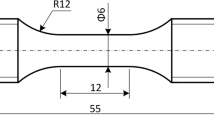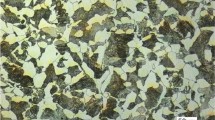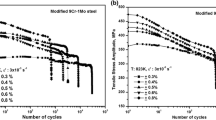Abstract
This work studied the low-cycle fatigue (LCF) behavior of HS80H steel at room temperature. LCF tests at strain amplitudes of 0.4, 0.6, 0.8, 1.0, 1.2, 1.6, and 2.0% were conducted under constant mean strain. In addition, tests at mean strains of −0.8, −0.3, 0, 0.5, and 1.2% were conducted under constant strain amplitude. The microstructure and fracture surface of the material after the tests were characterized using scanning electron microscopy and transmission electron microscopy, respectively. Results of LCF test demonstrate the hardening-softening transition of HS80H steel. And it is associated with strain amplitude and mean strain. In addition, LCF life is affected by strain amplitude and mean strain. In asymmetric fatigue, the maximum absolute value of strain and fatigue life displays a linear relationship in double logarithmic coordinates. Microscopic observation showed that fatigue crack propagates through transgranular propagation resulting from the interaction between dislocation pileup and precipitates.












Similar content being viewed by others
References
X. Zhu, S. Liu, and H. Tong, Plastic Limit Analysis of Defective Casing for Thermal Recovery Wells, Eng. Fail. Anal., 2013, 27, p 340–349
S. Liu, H. Zheng, X. Zhu, and H. Tong, Equations to Calculate Collapse Strength of Defective Casing for Steam Injection Wells, Eng. Fail. Anal., 2014, 42, p 240–251
J. Wu and M. Knauss, Casing Temperature and Stress Analysis in Steam-Injection Wells, International Oil & Gas Conference and Exhibition in China, Society of Petroleum Engineers, 2006
Z.-H. Yu, L.-Y. Wang, and D.-W. Liu, Investigation on Production Casing in Steam-Injection Wells and the Application in Oilfield, J. Hydrodyn. Ser. B, 2009, 21(1), p 77–83
H. Gu, L. Cheng, S. Huang, B. Bo, Y. Zhou, and Z. Xu, Thermophysical Properties Estimation and Performance Analysis of Superheated-Steam Injection in Horizontal Wells Considering Phase Change, Energy Convers. Manag., 2015, 99, p 119–131
X. Yang, Y. Yan, J. Wang, Z. Xu, and X. Yan, Strain Design and Experimental Study of Casing in Thermal Recovery Well Based on the Elastic-Plastic Constitutive Model, Pipelines 2013: Pipelines and Trenchless Construction and Renewals—A Global Perspective, 2013, p 1492–1500
L.J. Han, J.H. Jia, and Z.L. Yan, A Casing Design Method Based on Strain Variations for Wells in Thermal Recovery Processes, J. China Univ. Pet., 2014, 38(3), p 68–72
J. Ahmad, J. Purbolaksono, and L.C. Beng, Thermal Fatigue and Corrosion Fatigue in Heat Recovery Area Wall Side Tubes, Eng. Fail. Anal., 2010, 17(1), p 334–343
E. Poursaeidi and H. Bazvandi, Effects of Emergency and Fired Shut Down on Transient Thermal Fatigue Life of a Gas Turbine Casing, Appl. Therm. Eng., 2016, 100, p 453–461
I. Nikulin, T. Sawaguchi, A. Kushibe, Y. Inoue, H. Otsuka, and K. Tsuzaki, Effect of Strain Amplitude on the Low-Cycle Fatigue Behavior of a New Fe-15Mn-10Cr-8Ni-4Si Seismic Damping Alloy, Int. J. Fatigue, 2016, 88, p 132–141
I. Nikitin and M. Besel, Correlation Between Residual Stress and Plastic Strain Amplitude During Low Cycle Fatigue of Mechanically Surface Treated Austenitic Stainless Steel AISI, 304 and Ferritic–Pearlitic Steel SAE 1045, Mater. Sci. Eng. A, 2008, 491(1-2), p 297–303
D.R. Carter, W.E. Caler, D.M. Spengler, and V.H. Frankel, Fatigue Behavior of Adult Cortical Bone: The Influence of Mean Strain and Strain Range, Acta Orthop. Scand., 1981, 52(5), p 481–490
S.S. Manson, Interface Between Fatigue, Creep and Fracture, Int. J. Fract., 1966, 2(1), p 327–363
S. Sankaran, V.S. Sarma, and K.A. Padmanabhan, Low Cycle Fatigue Behavior of a Multiphase Microalloyed Medium Carbon Steel: Comparison Between Ferrite–Pearlite and Quenched and Tempered Microstructures, Mater. Sci. Eng. A, 2003, 345(1-2), p 328–335
M. Sauzay and L.P. Kubin, Scaling Laws for Dislocation Microstructures in Monotonic and Cyclic Deformation of FCC Metals, Prog. Mater. Sci., 2011, 56(6), p 725–784
M.F. Giordana, P.F. Giroux, I. Alvarez-Armas, M. Sauzay, A. Armas, and T. Kruml, Microstructure Evolution During Cyclic Tests on EUROFER 97 at Room Temperature. TEM Observation and Modelling, Mater. Sci. Eng. A, 2012, 550, p 103–111
M.N. Batista, M.C. Marinelli, S. Hereñú, and I. Alvarez-Armas, The Role of Microstructure in Fatigue Crack Initiation of 9-12%Cr Reduced Activation Ferritic–Martensitic Steel, Int. J. Fatigue, 2015, 72, p 75–79
R. Wan, Advanced Well Completion Engineering, 3rd ed., Elsevier Inc, Oxford, UK, 2011, p 221–294
Institution BS, Iso/cd 12106—Metallic Materials—Fatigue Testing Axial Strain—Controlled Method, 2003
Z. Shen, R.H. Wagoner, and W.A.T. Clark, Dislocation Pile-Up and Grain Boundary Interactions in 304 Stainless Steel, Scr. Metall., 1986, 20(6), p 921–926
D. Kiener, C. Motz, W. Grosinger, D. Weygand, and R. Pippan, Cyclic Response of Copper Single Crystal Micro-Beams, Scr. Mater., 2010, 63(5), p 500–503
A. Niesłony, C.E. Dsoki, H. Kaufmann, and P. Krug, New Method for Evaluation of the Manson–Coffin–Basquin and Ramberg–Osgood Equations with Respect to Compatibility, Int. J. Fatigue, 2008, 30(10-11), p 1967–1977
K. Shimada, J. Komotori, and M. Shimizu, The Applicability of the Manson–Coffin Law and Miner’s Law to Extremely Low Cycle Fatigue, Trans. Jpn. Soc. Mech. Eng. Part A, 1987, 53(491), p 1178–1185
H. Hao, D. Ye, and C. Chen, Strain Ratio Effects on Low-Cycle Fatigue Behavior and Deformation Microstructure of 2124-T851 Aluminum Alloy, Mater. Sci. Eng. A, 2014, 605, p 151–159
X. Wei, S.C. Wong, and S. Bandaru, A Semi-empirical Unified Model of Strain Fatigue Life for Insulation Plastics, J. Mater. Sci., 2010, 45(2), p 326–333
L. Lin, X. Li, J. Tan, and J. Zhang, Ultrasonic Power Spectral Analysis for Heat Treatment Transformation Products in GCr15SiMn Steel, Trans. Mater. Heat Treat., 2002, 04, p 21–24+73
J.G. Liu, M.W. Fu, and W.L. Chan, A Constitutive Model for Modeling of the Deformation Behavior in Microforming with a Consideration of Grain Boundary Strengthening, Comput. Mater. Sci., 2012, 55(55), p 85–94
L. Wang, Q. Liu, and S. Shen, Effects of Void–Crack Interaction and Void Distribution on Crack Propagation in Single Crystal Silicon, Eng. Fract. Mech., 2015, 146, p 56–66
X.L. Xu and R.K.N.D. Rajapakse, Analytical Solution for an Arbitrarily Oriented Void/Crack and Fracture of Piezoceramics, Acta Mater., 1999, 47(47), p 1735–1747
S.Y. Liu and I.W. Chen, Fatigue of Yttria-Stabilized Zirconia: II. Crack Propagation, Fatigue Striation, and Short Crack Behavior, J. Am. Ceram. Soc., 1991, 74(6), p 1206–1216
Acknowledgments
This work was supported by the National Natural Science Foundation of China under Contact No. 51574278.
Author information
Authors and Affiliations
Corresponding author
Rights and permissions
About this article
Cite this article
Wei, W., Han, L., Wang, H. et al. Low-Cycle Fatigue Behavior and Fracture Mechanism of HS80H Steel at Different Strain Amplitudes and Mean Strains. J. of Materi Eng and Perform 26, 1717–1725 (2017). https://doi.org/10.1007/s11665-017-2575-0
Received:
Revised:
Published:
Issue Date:
DOI: https://doi.org/10.1007/s11665-017-2575-0




